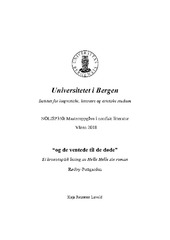| dc.contributor.author | Lavold, Kaja Reisæter | |
| dc.date.accessioned | 2018-08-28T08:08:55Z | |
| dc.date.available | 2018-08-28T08:08:55Z | |
| dc.date.issued | 2018-06-22 | |
| dc.date.submitted | 2018-06-21T22:00:10Z | |
| dc.identifier.uri | https://hdl.handle.net/1956/18278 | |
| dc.description.abstract | I denne oppgåva blir det presentert ei undersøking av kronotopar i Helle Helle sin gjennombrotsroman Rødby-Puttgarden (2005). Denne vart Helle sitt store gjennombrot og er den tredje av hennar romanutgjevingar. Med utgangspunkt i Mikhail Bakhtin sitt kronotopomgrep har eg drøfta korleis den typiske småbykronotoptida, har påverka tida i tre av romanen sine kronotopar. Der det seinmoderne har påverka kronotopane, har eg tatt i bruk Marc Augé sin teori om ikkje-staden presentert i Non-Places. Introduction to an anthropology of supermodernity (1992). Karakteren Jane er undersøkt ved hjelp av Bakhtin sitt omgrep, spesielt med bruk av terskelkronotopen. I lesinga av romanen er Bakhtin sin kronotop blitt brukt som utgangspunkt for å skildre korleis geografiske stader i romanen inneheld forskjellige framstillingar av tid og verdiar. Omgrepet gjer det mogleg å forklare korleis karakteren stiller seg i høve til stadene med det den inneberer av tid og verdiar. Karakteren sitt forhold til staden er òg prega av seinmoderne endringar i tid og rom. Derfor har Anthony Giddens sine sosiologiske teoriar kring den seinmoderne identiteten slik han presenterer det i Modernitet og selvidentitet (1991), vore del av karakterundersøkinga. Frå Rødby-Puttgarden presenterer eg rødbyhavnkronotopen, hamburgkronotopen og ferjekronotopen. Jane er nært knytt til rødbyhavnkronotopen til tross for at ho oppheld seg på andre stader og er i møte med andre kronotopar. Rødbyhavnkronotopen inneberer ei syklisk og saktegåande tid, noko som òg pregar heile romanen sin diskurs. Den har fleire trekk som Bakhtin hevdar er typisk for småbykronotopen. Den er prega av tradisjonelle verdiar, fortid, det finst regressive element og kvardagen er tydeleg. Til tross for at Hamburg- og ferjekronotopen er prega av notida og i større grad ein autonom identitet, er småbytida gjeldande òg i desse kronotopane. Dei potensielle terskelkronotopane, som legg opp til at karakterane kan setje i verk ei større endring eller utvikling, er òg prega av den saktegåande tida. Òg desse blir skildra som om dei var del av kvardagen sin normalitet. Til tross for det kvardagselege og saktegåande, skjer det ei karakterutvikling i løpet av romanen, og Jane kjem i møte med ein terskelkronotop som endrar henne som karakter. | en_US |
| dc.description.abstract | This thesis presents a survey of chronotopes in Helle Helle’s novel Rødby-Puttgarden (2005). The novel was Helle's major breakthrough and is her third novel. Based on Mikhail Bakhtin’s chronotope, I have discussed how the typical provincial town-time has influenced the time space in three of the novels chronotopes. Where the late modern changes have influenced the chronotopes, Marc Augé’s theory of non-places as presented in Non-Places. Introduction to an anthropology of supermodernity (1992) was used is being used. The character Jane is was examined using Bakhtin's chronotopes of threshold. During the reading of the novel, Bakhtin's chronotope has been used as a base to depict how geographical places in the novel contains different presentations of time and value. The terminology makes it possible to explain the character from the correlation between the places and what it implies of time and worth. The characters relationship to the place is also characterized by late modern changes in time and space. For that reason, Anthony Gidden’s sociological theories about the late modern identity as presented in Modernity and Self-Identity (1991) has been a part of the character survey. From Rødby-Puttgarden I present three different chronotopes, these are the chronotopes of Rødbyhavn, the ferry and of Hamburg. Jane is closely linked to the chronotope of Rødbyhavn, despite being in other places and facing other chronotopes. The chronotope of Rødbyhavn involves a cyclical and slow-moving time, which impacts the discourse in the novel as a whole. It has numerous features that Bakhtin claims is typical for the chronotope for provincial towns. It is clearly characterized by traditional values, the past, the regressive element and of everyday life. Despite the fact that the chronotope of Hamburg and the ferry are characterized by the present and an autonomous identity, the provincial time is also present in these chronotopes. The potential threshold chronotopes, makes it possible for the character to make a larger change or development while these are still affected by a slower time, as we know it from the provincial chronotope. These are described as if they are a part of a the everyday. In spite of this, there is a character development during the novel, and Jane meets a threshold chronotope that changes her as a character. | en_US |
| dc.language.iso | nno | eng |
| dc.publisher | The University of Bergen | eng |
| dc.subject | Dansk litteratur | |
| dc.subject | Litterær analyse | |
| dc.subject | Kronotop | |
| dc.title | "og de ventede til de døde" - Ei kronotopisk lesing av Helle Helle sin roman Rødby-Puttgarden | eng |
| dc.type | Master thesis | |
| dc.date.updated | 2018-06-21T22:00:10Z | |
| dc.rights.holder | Copyright the author. All rights reserved | eng |
| dc.description.degree | Mastergradsoppgåve i nordisk | |
| dc.description.localcode | NOLISP350 | |
| dc.subject.nus | 711123 | eng |
| fs.subjectcode | NOLISP350 | |
| fs.unitcode | 11-21-0 | |
